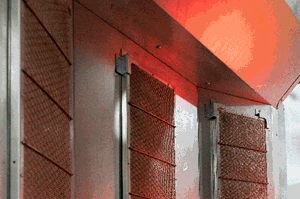Take the Paint Efficiency Audit
Achieve cost savings through more efficient finishing operations. As finishing operations look to stay competitive in an increasingly global economy, it’s no surprise that efficiency has become a popular topic.
As finishing operations look to stay competitive in an increasingly global economy, it’s no surprise that efficiency has become a popular topic. Many companies are looking for effective ways to reduce operating costs and improve profit margins.
Those interested in managing costs can make impactful changes by auditing the efficiency of current equipment, identifying process or equipment improvements and implementing the necessary changes.
Transfer Efficiency
When it comes to spraying parts on a paint line, efficiency improvements can lead to material savings by producing less waste and lower emissions of VOCs. There are many factors that affect transfer efficiency, including:
Proper gun setup. Proper air pressure and fluid pressure are critical for transfer efficiency. Too much air pressure will cause turbulence in the sprayed material, causing excessive overspray. Too much fluid pressure will cause bounce back of material off the substrate, both resulting in reduced transfer efficiency. Using the paint gun manufacturer’s suggested air cap and fluid tip combination for the viscosity of the product being sprayed will provide the best results in finish quality and efficiency.
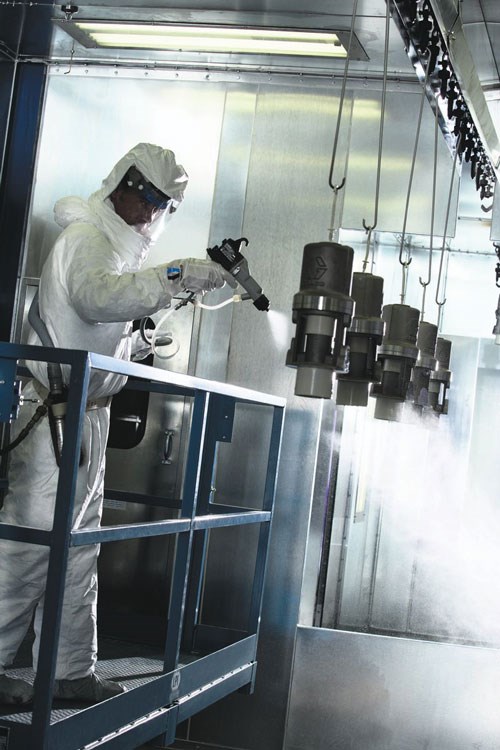
Size and shape of the part. To improve transfer efficiency, it is important that the spray pattern height matches the part being sprayed. Material blow-by from too large of a spray pattern reduces transfer efficiency. The tip size should be sized to the largest spray pattern height for the parts, but not bigger. It is also important to purchase a spray gun with a fan pattern adjustment knob so that, as the part size varies, the operator can adjust the spray pattern height down to match the part size.
Operator technique. Optimal operator training can have a big impact on transfer efficiency. Operator spray techniques such as spraying the right distance from the part, spraying parallel to the part, and triggering and detriggering at the proper time can affect transfer efficiency by 10 to 30 percent.
For example, it is important to overlap each successive stroke (e.g., 50 percent for conventional spraying or 25 percent for airless spraying) using a crosshatch overlap when required. Triggering the spray gun at the beginning and detriggering at the end of each stroke is recommended. This minimizes the lead, and even a small decrease in leading and trailing edges can reduce overspray and result in significant improvements in transfer efficiency.
Applicator selection. Selecting the most efficient spray gun for the intended application is important in optimizing the efficiency of any spray operation. Conventional air spray, compliant, HVLP, air-assist and electrostatic all offer excellent benefits, depending on the application.
Mix Room Equipment
In the mix room of finishing operations, pumps are often the biggest consumers of energy as a result of compressed air consumption. Improving the efficiency of current equipment, or switching to hydraulic or electric pumps that use less energy are effective ways to reduce long-term energy consumption. Pneumatic systems are often the choice of most finishing operations because they are easy to install and operate. And because air is often an existing power source in the plant, the upfront cost is typically less expensive.
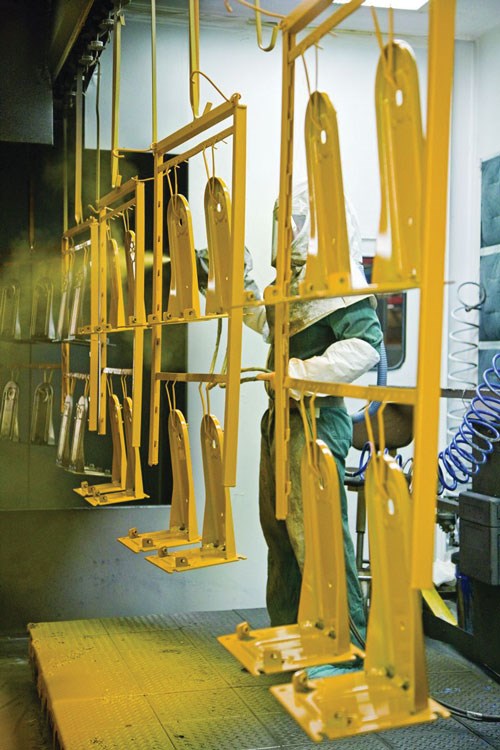
Hydraulic systems are more cost-efficient than pneumatic systems because they use about 1/3 of the energy of pneumatic systems. A system using hydraulics can match the power of a pneumatic system even if the horsepower of the hydraulic system is listed as less than that of the pneumatic system.
With the highest up-front expense, electric motors often provide the largest energy savings in a finishing operation. Most notably, they offer direct conversion of electrical energy to mechanical pumping. This not only uses less energy, but it also eliminates the inefficiency of compressed air systems. A table on the next page illustrates how switching from pneumatic to electrical pumps can yield thousands of dollars in savings for finishing operations.
Air compressors have ongoing liabilities, including leaks, maintenance and equipment downtime that can also lead to inefficiencies. In fact, the majority of air compressor costs are not from the initial capital investment but from energy usage in their 10-year lifespan.
Another benefit of electrical pumping is the improved control and automation potential. Pumps can be set up to operate only when absolutely needed, and these off-production settings greatly reduce or eliminate energy consumption during off shifts or non-peak operating modes.
Another area to evaluate for efficiency is the process of proportioning plural component materials. More finishing operations are using plural component paint because it offers better adhesion, hardness and durability, and lower VOC output and oven cure. But in order to be successful with 2K and 3K coatings, the material needs to be mixed at the correct ratio and used before it cures.
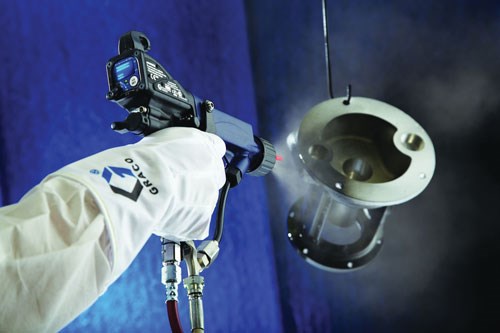
One way to manage this process is to use electronic proportioning machines that not only mix the materials accurately, but also mix on demand as you spray them. In addition to saving an operator’s time when compared with hand mixing, electronic proportioners reduce waste and contain state-of-the-art diagnostics that can keep manufacturing processes running smoothly and efficiently. In most cases, an electronic proportioning system pays for itself within months of purchase.
Facility Assessments
Even with these large savings opportunities, evaluating long-term cost savings is critical when considering the expense of purchasing and installing new equipment. There are several manufacturers that offer facility reviews to help identify product or process improvements. They may also provide other tools such as return on investment calculators to help determine if installing new technology is right for your application. In addition to this, many utility companies provide resources and rebates for manufacturers that install new energy-efficient equipment in their plants.


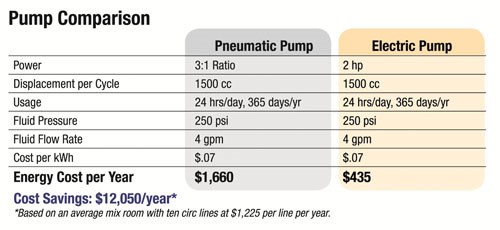
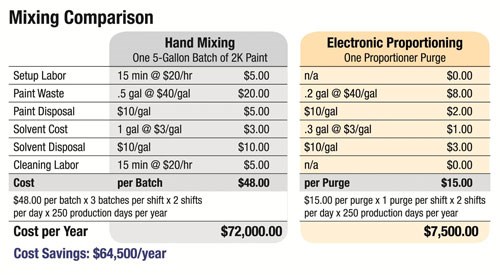
The U.S. Department of Energy also has many free tools that help manufacturers through an energy-efficiency process, from measuring energy use at specific points in a production line to determining the best approach to installing more efficient equipment and developing an energy-savings plan. These include the department’s Pumping System Assessment Tool, the Compressed Air Scorecard and many other energy-management resources.
Overall, developing a long-term plan is essential for manufacturers looking to achieve significant energy and bottom-line savings. Operating with the most energy-efficient technology available and proper training on equipment may provide the largest savings, but no opportunity is too small, because it all adds up.
Nick Strauss is the marketing manager, Industrial Products Division, for Graco Inc. in Minneapolis. For more information, please visit graco.com.
Graco Inc.-Industrial Products Division
Related Content
Specialty Oven’s Hot Benefits and Other Questions Answered
Learn about the advantages of gas catalytic infrared pre-gel ovens in this article, including how they are energy efficient and can save users time and money when integrated into their existing systems.
Read MoreCatalytic Gel Ovens Offer Small Operational Footprint
WolfRayet catalytic gel ovens offer small operational footprints while also providing a way to improve on existing convection curing.
Read MorePowder Coating Overcomes Post Forming
Six Sigma methodology, open communication, and collaboration produce results for leading boat manufacturer.
Read MoreImmersion Heaters for Finishing
The company’s metal finishing product range includes stainless steel, Incoloy, titanium and fluoropolymer (PTFE) over the side heaters.
Read MoreRead Next
Painting Proportioners Becoming Popular With Finishers
Offer high ratio accuracy, various flow rates
Read MoreA ‘Clean’ Agenda Offers Unique Presentations in Chicago
The 2024 Parts Cleaning Conference, co-located with the International Manufacturing Technology Show, includes presentations by several speakers who are new to the conference and topics that have not been covered in past editions of this event.
Read MoreDelivering Increased Benefits to Greenhouse Films
Baystar's Borstar technology is helping customers deliver better, more reliable production methods to greenhouse agriculture.
Read More













